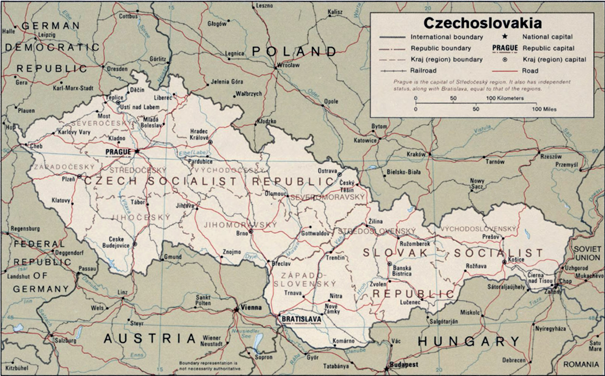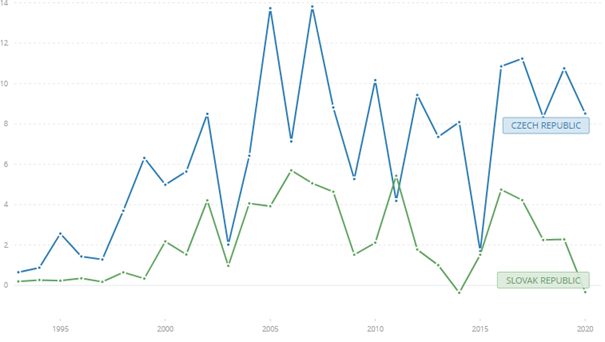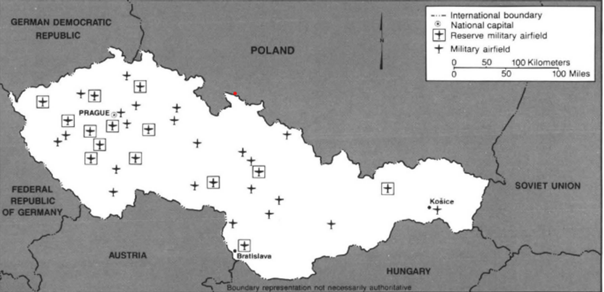Kutatás / Geopolitika
29 Years of the Czech Armed Forces
Czechia managed to build a relatively small but effective armed force in almost three decades. In this era, the country has become economically capable of further increasing its defence. The war in Ukraine proves that investing in the military can be nation-saving, and a smaller number of high-tech assets on the battlefield can overcome even larger but obsolete forces. In the light of this knowledge, new military infrastructure is to be procured in the following years.
The birth of the independent Czechia
After the disintegration of Czechoslovakia, the successor states took completely different routes. While the Slovak Republic started to look for its proper place in the international community and continuously balanced between East and West, Czechia immediately stepped on the Western course. From the first moment of independence, the country dedicated all its moves to becoming integrated into the European economic bloodstream and loudly articulated its goal of joining NATO and the European Union as soon as possible. Czechia ably overcame all obstacles, and thanks to its professional leadership, it was included in the first expansion round aimed at integrating countries of the former Eastern bloc by both organisations.
Figure 1: Former Czechoslovakia in 1985. Source: Mapsland.com[i]
The rise of the economy
After the disintegration of Czechoslovakia, the successor state Czech Republic possessed advantages in many fields compared to the Slovak Republic. Unlike its Slovak counterpart, the Czech industry has always been cutting-edge. Thanks to the country’s functioning democracy, professional leadership, clear goals and geographical proximity to Germany, foreign capital started flowing into Prague and the whole republic. The most symbolic sign of the Western economic penetration was the acquisition in 1991 of Škoda, the iconic Czech industrial company, by the Volkswagen Group.[ii] Thanks to this cooperation, the Central European car-manufacturer brand, which experienced many difficulties during the socialist era, produces world-class vehicles today sold on every continent.
Figure 2: FDI, net inflows (BoP, current USD) - Czech Republic, Slovak Republic.
Source: The World Bank[iii]
The World Bank graph above clearly indicates that since 1993, there was only one year when more direct investment headed to Slovakia than to Czechia. Thanks to the internationalisation of its inner market, the Czech gross domestic product instantly started to rise after the breakup. High-quality products and advanced technologies entered the country, resulting in a decreased unemployment rate. These tendencies started to accelerate immediately once the NATO accession was completed in 1999 and became spectacular after the EU enlargement in 2004.
The outcome of these impacts can also be observed in Figure 3. The evolution of the gross domestic product in current USD regarding the post-Czechoslovak countries is far not even.
Figure 3: GDP per capita (current USD) - Czech Republic, Slovak Republic. Source: The World Bank[iv]
If we compare the World Bank Data regarding the two countries’ GDP per capita, we can see that they were the closest at the end of the Czechoslovak era in 1991, when the difference was minimal, only around 205 US dollars. According to the chart, this discrepancy rose dramatically over the last three decades and was slightly more than 5,290 USD in 2020.[v] This data is shocking because, to this day, broad layers of the population in Slovakia justify the need for dismantling the federal state out of the perception that in Czechoslovakia, the “Slovaks had to work for the Czechs.”
Status of the armed forces
The Czechoslovak Socialist Republic had an internationally recognised armaments industry whose customers were primarily the Arabic states and the members of the Warsaw Pact Organisation (WPO). After the Velvet Revolution, many of these production lines were demolished, not because of economic but ideological reasons. In the background of this naïve step was the belief that this more than symbolic move toward a gun-free world would improve the country’s international image and contribute to world peace. However, its actual effect was that factories closed down, people lost their jobs, resentment against the leadership in Prague grew, and other actors replaced Czechoslovak suppliers.
The publication Czechoslovakia: A Country Study,[vi] available on the Official Website of the US Marine Corps,[vii] provides highly detailed data on the composition of the armaments of the Czechoslovak People's Army in 1987. According to the document, the number of active military personnel was around 201,000, of which approximately 100,000 were conscripts.[viii] At that time, the Czechoslovaks possessed around 3,000 tanks. The number of artilleries was around 1,000 pieces. There were nuclear-capable rocket launchers in the inventory as well.
The Czechoslovak Air Force’s primary mission was to guarantee the safety of the country’s airspace and to provide air support for the ground forces in case of a conflict. According to the source mentioned above, in 1987, the air force crew was around 56,000, two-thirds of which were career personnel. They possessed 465 combat aircraft (mainly MiG-21, MiG-23, Su-22, Aero L-19, and An-24) and approximately 40 armed helicopters. In 1987, 22 military and 14 reserve military airfields were operated in Czechoslovakia. Six of the latter were used in civil aviation.
Figure 4: Military and Reserve Military Airfields in 1987. Source: Czechoslovakia: A Country Study[ix]
Military building of Czechia
When the independent Czechia was born on 1 January 1993, in the process of army-building, it could rely on two primary sources: the Czechoslovak Army's remains and the country's old legionnaire tradition. At the time of the split, an agreement was made between the parties to distribute military assets among the successor states in a two-to-one ratio, favouring the Czech Republic.[x] Immovable infrastructure was inherited by the country on whose territory that was located. This deal caused practical problems in Prague and Bratislava since not all types of facilities and infrastructure became available in the successor states. However, this inconvenience was resolved on both sides operatively. After the fall of the socialist regime, due to intense public pressure, the originally two-year-long compulsory military service was reduced to 18 months, then further shortened. After the NATO accession, conscription was terminated.[xi] Today the Czech Army is built on a professional basis.[xii] According to official sources, the number of personnel in the Czech Military by the end of 2021 was 35,127, of which 26,928 were career soldiers and 7,090 civilian employees. The number of the active reserve was 3,615.[xiii]
Article 3-4 of the Constitutional Act No. 110/1998 says that „[s]ecurity of the Czech Republic is ensured by its armed forces, armed security forces, rescue brigades and emergency services. All state authorities, all bodies of territorial self-governing units and all legal entities and private persons are obligated to participate in security operations. The extent of obligations and other details are specified by the law.”[xiv] The mentioned security branches' primary task is to provide defence against external attacks. NATO membership concerning Article 5 of the Washington Treaty also provides invaluable security guarantees for the state.
Armed Forces
The Armed Forces of the Czech Republic (CAF) are divided into the Army of the Czech Republic, the Military Office of the President of the Republic and the Castle Guard. The CAF is headed by the President of the state. The Ministry of Defence is responsible for the development and control of the military.
Joint Forces of the Army are created to accomplish tactical or operational objectives inland and abroad. The Ground Forces represent the most numerous parts of the army. Their members are trained to be capable of conducting operations on a national basis but also within a NATO task force. [xv] The Ground Forces usually constitute the basis for international operations. Since 1993, they have participated in UNPROFOR, UNCRO, IFOR, SFOR, SFORII, KFOR, ISAF, EUFOR ALTHEA, EOD, METEO, and many other missions.[xvi]
Equipment
The protection of the airspace of the Czech Republic is guaranteed by its Air Force[xvii] in the framework of the NATO Integrated Air and Missile Defence System. Modernisation of the armed forces was a condition for joining NATO. In 2003 the Czech government made an agreement[xviii] with the Swedish company Saab AB and leased 14 pieces of Gripen JAS-39 fighter jets, 12 single-seat and two two-seat versions.[xix] The advanced military assets have created new capabilities for the Czech Air Force. Because of the NATO bond, Czechia takes part in safeguarding the airspace of the Baltic allies.[xx] Moreover, according to the current news, the Czech Republic will also protect Slovakia’s airspace in the near future.[xxi]
Thanks to the deal made with the Saab AB, the jets’ lease date has been extended until 2027.[xxii] According to the latest news, however, the Czech Republic is planning to replace the Gripens with the fifth-generation US-made F-35A fighter jets. Media sources report negotiations about purchasing 24 pieces of the world's most advanced but, on the other hand, extremely expensive machines. The purchase of the state-of-the-art technology would be surprising in light of the fact that in case of buying the Gripen JAS-39E jets Saab would have allowed the Czechs to keep the currently used Gripens for free.[xxiii] Regarding rotary-wing capabilities, at present the Czech Air Force relies on modernised versions of Soviet-made equipment.[xxiv]
The same applies on the ground. Before the outbreak of the war in Ukraine, the backbone of the armoured capabilities consisted mainly of advanced versions of Soviet-made T-72 tanks.[xxv] However, it is questionable if the country still possesses these assets. Since the outbreak of the war, like many other NATO member states, Czechia has provided military assistance to Ukraine. According to media sources, several dozen modernised T-72M tanks and infantry fighting vehicles were donated to Ukraine. The worth of the contribution just until April reached 1 billion CZK (40 million USD).[xxvi] Currently, there is no available public document expounding how the composition of the CAF has changed. What we know for sure is that there are ongoing negotiations regarding the purchase of Swedish infantry fighting vehicles between the producer and the Ministry of Defence and the Armed Forces of the Czech Republic.[xxvii]
Legal background
In 2011, the Czech Republic adopted a White Paper on defence policy, which assessed the relatively poor situation of the armed forces at the time. In 2019, the Czech government approved the Army Construction Concept of the Czech Republic 2030.[xxviii] According to the document, in less than a decade, the capabilities of the Czech Armed Forces will fully correspond to the required NATO standards, and the country will be able to fulfil its international obligations entirely and contribute to the collective defence on a higher level. The CAF will be able to operate in joint operations of great variety and a wide range of intensity, using state-of-the-art technologies, procedures and equipment. The completed modernisation will free the Czech Armed Forces from dependence on technology of Russian provenance and the need to constantly struggle for operability.
By 2030, the Army of the Czech Republic will be made up of land, air and special forces, cyber and territorial force units. Logistics will be divided into the 1st to 4th levels with organic elements in the ACR force structure. According to the plan, by 2030, the military units and facilities will be filled to more than 90% of their total capacity with prepared, qualified and motivated personnel.[xxix]
Conclusion
History did not end in 1990. Indeed, in 2022, Eastern Europe is on fire again. Even though national defence is expensive, it is essential to statehood. In the anarchic international system, any country that cannot defend itself is constantly risking its existence. Although the size of the Czech Armed Forces today is only a shadow of the former Czechoslovak one, it still has the capabilities necessary for defence. If the planned acquisitions are realised, the Czech Republic could have one of the most modern forces in the Central European Region by 2030.
Bibliography
Airforce Magazine: Czech Republic Plans to Buy F-35 as New Fighter, Would Be 16th Customer. <20.07.2022> Access:
https://www.airforcemag.com/czech-republic-plans-to-buy-f-35s-as-new-fighter-would-be-16th-customer/ (24.07.2022)
BINAR, Aleš: Ozbrojené síly a Československý stát. Univerzita obrany v Brne. Brno, 2020. ISBN 978-80-7582-353-3. p.358
Britské listy: Vláda rozhodla o stíhačkách - vyhrál švédský gripen. <18.12.2003> Access: https://legacy.blisty.cz/art/16309.html (24.07.2022)
Czechoslovakia: A Country Study; Manpower, barbed wire, and electronics – important elements of national security in Czechoslovakia. pp. 235-238 Access: https://www.marines.mil/portals/1/Publications/Czechoslovakia%20Study_4.pdf?ver=2012-10-11-163237-750. (22.07.2022)
Defense Update: Czech Republic extend Gripen lease through 2027 <12.12.2014> Access: https://defense-update.com/20141212_cz_gripen.html (29.07.2022)
E15.CZ: Česko zřejmě poslalo Ukrajině několik desítek tanků a bojových vozidel pěchoty <05.04.2022> Access: https://www.e15.cz/valka-na-ukrajine/cesko-zrejme-poslalo-ukrajine-nekolik-desitek-tanku-a-bojovych-vozidel-pechoty-1389046 (24.07.2022)
GAWDIAK, Ihor: Czechslovakia – a country study. In. Federal Research Division Library of Congress. <1987> Access: https://www.marines.mil/portals/1/Publications/Czechoslovakia%20Study_1.pdf?ver=2012-10-11-163237-750 (22.07.2022)
MAPSLAND.COM: Detailed political map of the former Czechoslovakia in 1985. Access: https://www.mapsland.com/maps/europe/czech-republic/large-detailed-political-and-administrative-map-of-czechoslovakia-with-roads-and-major-cities-1985.jpg (20.07.2022)
Marines Official. Access: https://www.marines.mil/ (22.07.2022)
Military Factory: Saab JAS 39 Gripen. <08.04.2022> Access: https://www.militaryfactory.com/aircraft/detail.php?aircraft_id=67
MoD CZ: Air Force. Access: https://www.army.cz/scripts/detail.php?id=87187 (24.07.2022)
MoD CZ: Brief Information on the Czech Republic, its Armed Forces and Military Reservation Training Facilities. Access: https://www.army.cz/images/id_5001_6000/5725/bo.pdf (24.07.2022) pp. 43-46
MoD CZ: Helicopters. Access: http://www.army.cz/en/armed-forces/equipment/air-force/helicopters/default.htm (24.07.2022)
MoD CZ: Koncepce výstavby Armády České republiky 2030. Access: http://mocr.army.cz/images/id_40001_50000/46088/koncepce__2030.pdf (24.07.2022)
MoD CZ: Personnel Size of the Defence Department in 1992 – 2021. <17.01.2022> Access:
https://www.army.cz/en/facts-file/personnel-size/personnel-size-of-the-defence-department-in-1992---2019-221441/ (22.07.2022)
MoD CZ: Tanks and Armoured Vehicles. Access: http://www.army.cz/en/armed-forces/equipment/air-force/helicopters/default.htm (24.07.2022)
Parliament of CZ: Constitutional Act of Law No. 110/1998 Coll., of April, 22nd 1998, on Security of the Czech Republic. Access: https://www.psp.cz/en/docs/laws/1998/110.html (22.07.2022)
SAAB Official: The Czech Air Force Marks 15 Years of Gripen Operations. <20.04.2020> Access: https://www.saab.com/newsroom/stories/2020/april/the-czech-air-force-marks-15-years-of-gripen-operations (24.07.2022)
Sbírka zákonů ČR: Zákon č. 585/2004 Sb. Access: https://www.zakonyprolidi.cz/cs/2004-585# (24.07.2022)
ŠKODA Official: Two Companies Write One History. <23.06.2016> Access: https://www.skoda-storyboard.com/en/skoda-world/two-companies-write-one-history/ (20.07.2022)
The World Bank: Foreign direct investment, net inflows (BoP, current USD) - Czech Republic, Slovak Republic. Access: https://data.worldbank.org/indicator/BX.KLT.DINV.CD.WD?end=2020&locations=CZ-SK&start=1993 (21.07.2022)
The World Bank: GDP per capita (current USD) - Czech Republic, Slovak Republic. Access: https://data.worldbank.org/indicator/NY.GDP.PCAP.CD?locations=CZ-SK (21.07.2022)
TREND.SK: Česká armáda bude viac než rok pomáhať s ochranou vzdušného priestoru SR <27.07.2022> Access: https://www.trend.sk/spravy/ceska-armada-bude-viac-nez-rok-pomahat-ochranou-vzdusneho-priestoru-sr (31.07.2022)
WATERS, Trevor: Budovanie armády z ničoho: namáhavý zápas Slovenska. In. Medzinárodné otázky, Vol. 7, No. 4. <1998> p. 63. Access: https://www.jstor.org/stable/44961031?read-now=1&refreqid=excelsior%3A5f83a5a51a8a580d8b248d22290c85db&seq=5 (22.07.2022)
Endnotes
[i] MAPSLAND.COM: Detailed political map of the former Czechoslovakia in 1985. Access: https://www.mapsland.com/maps/europe/czech-republic/large-detailed-political-and-administrative-map-of-czechoslovakia-with-roads-and-major-cities-1985.jpg (20.07.2022)
[ii] ŠKODA Official: Two Companies Write One History. <23.06.2016> Access: https://www.skoda-storyboard.com/en/skoda-world/two-companies-write-one-history/ (20.07.2022)
[iii] The World Bank: Foreign direct investment, net inflows (BoP, current USD) - Czech Republic, Slovak Republic. Access: https://data.worldbank.org/indicator/BX.KLT.DINV.CD.WD?end=2020&locations=CZ-SK&start=1993 (21.07.2022)
[iv] The World Bank: GDP per capita (current USD) - Czech Republic, Slovak Republic. Access: https://data.worldbank.org/indicator/NY.GDP.PCAP.CD?locations=CZ-SK (21.07.2022)
[v] Ibid.
[vi] GAWDIAK, Ihor: Czechslovakia – a country study. In. Federal Research Division Library of Congress. <1987> Access: https://www.marines.mil/portals/1/Publications/Czechoslovakia%20Study_1.pdf?ver=2012-10-11-163237-750 (22.07.2022)
[vii] Marines Official. Access: https://www.marines.mil/ (22.07.2022)
[viii] Czechoslovakia: A Country Study; Manpower, barbed wire, and electronics – important elements of national security in Czechoslovakia. pp. 235-238 Access: https://www.marines.mil/portals/1/Publications/Czechoslovakia%20Study_4.pdf?ver=2012-10-11-163237-750. (22.07.2022)
[ix] Ibid. p.240
[x] WATERS, Trevor: Budovanie armády z ničoho: namáhavý zápas Slovenska. In. Medzinárodné otázky, Vol. 7, No. 4. <1998> p. 63. Access: https://www.jstor.org/stable/44961031?read-now=1&refreqid=excelsior%3A5f83a5a51a8a580d8b248d22290c85db&seq=5 (22.07.2022)
[xi] BINAR, Aleš: Ozbrojené síly a Československý stát. Univerzita obrany v Brne. Brno, 2020. ISBN 978-80-7582-353-3. p.358
[xii] Sbírka zákonů ČR: Zákon č. 585/2004 Sb. Access: https://www.zakonyprolidi.cz/cs/2004-585# (24.07.2022)
[xiii] MoD CZ: Personnel Size of the Defence Department in 1992 – 2021. <17.01.2022> Access: https://www.army.cz/en/facts-file/personnel-size/personnel-size-of-the-defence-department-in-1992---2019-221441/ (22.07.2022)
[xiv] Parliament of CZ: Constitutional Act of Law No. 110/1998 Coll., of April, 22nd 1998, on Security of the Czech Republic. Access: https://www.psp.cz/en/docs/laws/1998/110.html (22.07.2022)
[xv] MoD CZ: Brief Information on the Czech Republic, its Armed Forces and Military Reservation Training Facilities. Access: https://www.army.cz/images/id_5001_6000/5725/bo.pdf (24.07.2022) pp. 43-46
[xvi] Ibid. p.46.
[xvii] MoD CZ: Air Force. Access: https://www.army.cz/scripts/detail.php?id=87187 (24.07.2022
[xviii] Britské listy: Vláda rozhodla o stíhačkách - vyhrál švédský gripen. <18.12.2003> Access: https://legacy.blisty.cz/art/16309.html (24.07.2022)
[xix] Military Factory: Saab JAS 39 Gripen. <08.04.2022> Access: https://www.militaryfactory.com/aircraft/detail.php?aircraft_id=67
[xx] SAAB Official: The Czech Air Force Marks 15 Years of Gripen Operations. <20.04.2020> Access: https://www.saab.com/newsroom/stories/2020/april/the-czech-air-force-marks-15-years-of-gripen-operations (24.07.2022)
[xxi] TREND.SK: Česká armáda bude viac než rok pomáhať s ochranou vzdušného priestoru SR <27.07.2022> Access: https://www.trend.sk/spravy/ceska-armada-bude-viac-nez-rok-pomahat-ochranou-vzdusneho-priestoru-sr (31.07.2022)
[xxii] Defense Update: Czech Republic extend Gripen lease through 2027 <12.12.2014> Access: https://defense-update.com/20141212_cz_gripen.html (29.07.2022)
[xxiii] Airforce Magazine: Czech Republic Plans to Buy F-35 as New Fighter, Would Be 16th Customer. <20.07.2022> Access:
https://www.airforcemag.com/czech-republic-plans-to-buy-f-35s-as-new-fighter-would-be-16th-customer/ (24.07.2022)
[xxiv] MoD CZ: Helicopters. Access: http://www.army.cz/en/armed-forces/equipment/air-force/helicopters/default.htm (24.07.2022)
[xxv] MoD CZ: Tanks and Armoured Vehicles. Access: http://www.army.cz/en/armed-forces/equipment/air-force/helicopters/default.htm (24.07.2022)
[xxvi]E15.CZ: Česko zřejmě poslalo Ukrajině několik desítek tanků a bojových vozidel pěchoty <05.04.2022> Access: https://www.e15.cz/valka-na-ukrajine/cesko-zrejme-poslalo-ukrajine-nekolik-desitek-tanku-a-bojovych-vozidel-pechoty-1389046 (24.07.2022)
[xxvii] Airforce Magazine: Czech Republic Plans to Buy F-35 as New Fighter, Would Be 16th Customer. <20.07.2022> Access:
https://www.airforcemag.com/czech-republic-plans-to-buy-f-35s-as-new-fighter-would-be-16th-customer/ (24.07.2022)
[xxviii] MoD CZ: Koncepce výstavby Armády České republiky 2030. Access: http://mocr.army.cz/images/id_40001_50000/46088/koncepce__2030.pdf (24.07.2022)
[xxix] Ibid.



